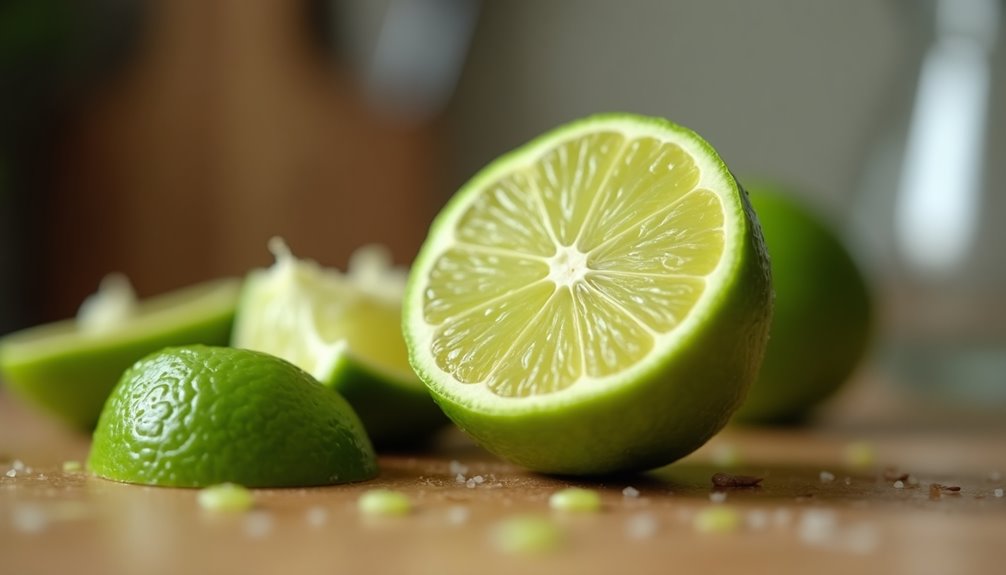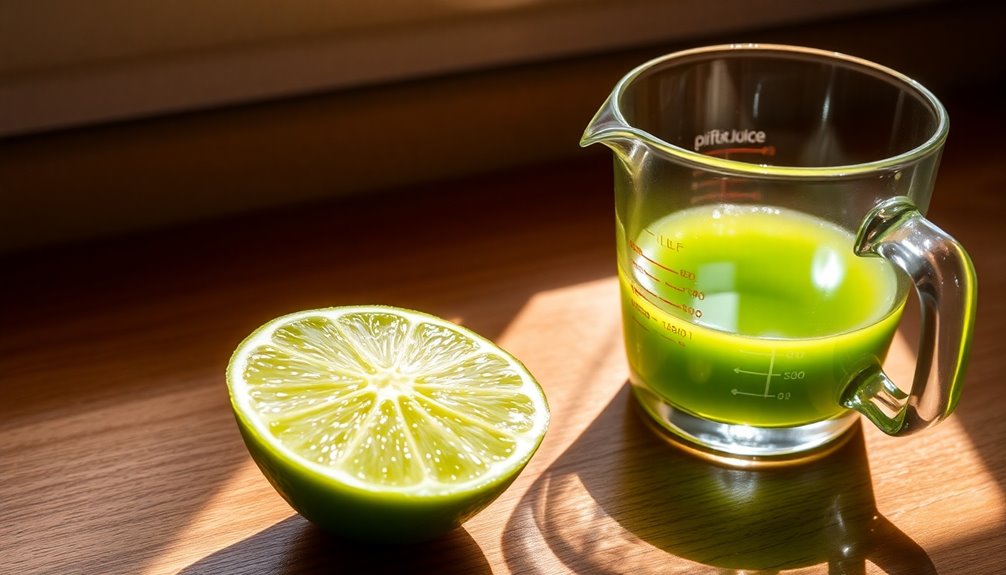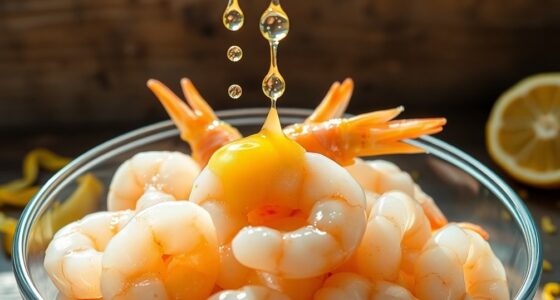Half a lime typically gives you about 1 tablespoon of juice, which is around 0.5 ounces or 15 milliliters. The exact yield can change based on the size and ripeness of the lime—perfectly ripe limes usually produce more. Fresh lime juice is a fantastic way to enhance your dishes and drinks, adding brightness and flavor. If you're curious about the many uses and benefits of lime juice, you'll discover even more fascinating information ahead.
Key Takeaways
- Half a lime typically produces about 1 tablespoon of juice.
- This is equivalent to roughly 0.5 ounces or around 15 milliliters.
- Juice yield can vary depending on the lime's size and ripeness.
- Ripe limes generally yield more juice compared to smaller or less ripe ones.
- Fresh lime juice enhances flavors and is versatile in various culinary applications.

Have you ever wondered how much juice you can expect from half a lime? Well, you're in for a treat. Typically, half a lime produces about 1 tablespoon of juice, which is roughly equivalent to 0.5 ounces or around 15 milliliters. This is a handy measurement to keep in mind, especially when you're whipping up fresh recipes that call for that zesty citrus flavor.
The amount of juice you get can vary slightly based on the size and ripeness of the lime. If you pick a perfectly ripe lime, you might find that it gives you a bit more juice. On the other hand, if the lime is smaller or not as ripe, you might end up with a little less. However, for most culinary needs, you can confidently estimate that half a lime will yield about a tablespoon of juice. This quantity generally works well for dressings, marinades, or beverages, making it a reliable go-to for many recipes.
Using fresh lime juice instead of bottled alternatives is a game-changer. When you squeeze that half lime, you unlock a vibrant flavor that simply can't be matched by anything that's been sitting on a shelf. Fresh juice brings a brightness to your dishes and drinks that elevates them to a whole new level.
Whether you're making a refreshing cocktail, a zesty salad dressing, or a savory marinade, that burst of fresh lime juice can really enhance the overall taste. If you're making something like guacamole or a citrus vinaigrette, just grab that half lime and juice it. The acidity from the lime not only adds flavor but also helps to balance the other ingredients. It cuts through richness and adds a delightful tang that can make a simple dish shine. You'll find that a tablespoon of fresh lime juice can go a long way in transforming your cooking.
When it comes to using lime juice in your recipes, think about how versatile it is. You can use it in both sweet and savory dishes. From a classic margarita to a tangy ceviche, lime juice is a staple in many cuisines. It's one of those citrus fruits that can tie together a variety of flavors, making it a must-have in your kitchen. Additionally, incorporating lime juice can also enhance your dishes with detoxifying properties, promoting overall wellness through its ability to aid in digestion and boost liver function.
Frequently Asked Questions
How Much Juice Is in 1 Lime?
When you juice one medium lime, you typically get about 2 tablespoons of fresh juice, which equals roughly 1 ounce.
This amount can vary slightly based on the lime's size and ripeness, but you can generally count on this yield for most recipes.
Using this juicy goodness can really enhance the flavors in your dishes, whether they're sweet or savory.
Can I Substitute Bottled Lime Juice for Fresh Lime Juice?
Did you know that a fresh lime can contain anywhere from 1 to 2 tablespoons of juice?
When it comes to substituting bottled lime juice for fresh, you can do it, but you might want to adjust for taste.
Bottled lime juice often lacks the vibrant flavor of fresh juice and may contain preservatives.
For dishes where lime's flavor shines, stick with fresh to get the best results and truly enjoy your meal.
What Is Half a Lime in Juice?
When you juice half a lime, you can expect to get about 1 tablespoon of juice, or roughly 0. 5 fluid ounces. The exact amount of juice can vary slightly depending on the freshness and size of the lime. On average, however, the juice content in half a lime is sufficient for flavoring dishes or adding a zesty kick to beverages. If you need more juice for recipes, consider using a whole lime for a more intense flavor profile.
This amount can vary slightly depending on the lime's size and ripeness.
If you want to maximize the juice, try rolling the lime on a countertop before cutting it.
This little trick can help you extract more juice, making your dishes or drinks even more flavorful with that fresh lime essence.
How Much Bottled Lime Juice Equals 1/2 Lime?
Isn't it amusing how we often seek the convenience of bottled lime juice, yet it sometimes pales compared to fresh?
To answer your question, you'll find that about 1 tablespoon of bottled lime juice equals the juice from half a lime.
While it saves you the hassle of squeezing, keep in mind that you might miss out on that zesty kick.
Conclusion
So, next time you slice a lime in half, you might just find yourself squeezing out about 1 to 2 tablespoons of juicy goodness. Isn't it funny how something so small can pack such a flavorful punch? Whether you're mixing up a refreshing drink or adding a zesty kick to a dish, half a lime can make all the difference. Who knew that one little fruit could brighten up your day just like that? Cheers to those zesty moments!
Cindy thoroughly researches juicing trends, techniques, and recipes to provide readers with practical advice and inspiration. Her writing style is accessible, engaging, and designed to make complex concepts easy to understand. Cindy’s dedication to promoting the advantages of juicing shines through her work, empowering readers to make positive changes in their lives through the simple act of juicing.
















